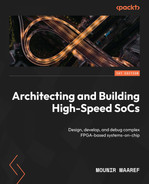Design a high-speed SoC while gaining a holistic view of the FPGA design flow and overcoming its challenges. Purchase of the print or kindle book includes a free eBook in the PDF format. Modern and complex SoCs can adapt to many demanding system requirements by combining the processing power of ARM processors and the feature-rich Xilinx FPGAs. You'll need to understand many protocols, use a variety of internal and external interfaces, pinpoint the bottlenecks, and define the architecture of an SoC in an FPGA to produce a superior solution in a timely and cost-efficient manner. This book adopts a practical approach to helping you master both the hardware and software design flows, understand key interconnects and interfaces, analyze the system performance and enhance it using the acceleration techniques, and finally build an RTOS-based software application for an advanced SoC design. You'll start with an introduction to the FPGA SoCs technology fundamentals and their associated development design tools. Gradually, the book will guide you through building the SoC hardware and software, starting from the architecture definition to testing on a demo board or a virtual platform. The level of complexity evolves as the book progresses and covers advanced applications such as communications, security, and coherent hardware acceleration. By the end of this book, you'll have learned the concepts underlying FPGA SoCs' advanced features and you'll have constructed a high-speed SoC targeting a high-end FPGA from the ground up. This book is for FPGA and ASIC hardware and firmware developers, IoT engineers, SoC architects, and anyone interested in understanding the process of developing a complex SoC, including all aspects of the hardware design and the associated firmware design. Prior knowledge of digital electronics, and some experience of coding in VHDL or Verilog and C or a similar language suitable for embedded systems will be required for using this book. A general understanding of FPGA and CPU architecture will also be helpful but not mandatory.Key Features
Book Description
What you will learn
Who this book is for
Table of Contents
- Architecting and Building High-Speed SoCs
- Contributors
- About the author
- About the reviewer
- Preface
- Part 1: Fundamentals and the Main Features of High-Speed SoC and FPGA Designs
- Chapter 1: Introducing FPGA Devices and SoCs
- Chapter 2: FPGA Devices and SoC Design Tools
- Chapter 3: Basic and Advanced On-Chip Busses and Interconnects
- Chapter 4: Connecting High-Speed Devices Using Buses and Interconnects
- Chapter 5: Basic and Advanced SoC Interfaces
- Part 2: Implementing High-Speed SoC Designs in an FPGA
- Chapter 6: What Goes Where in a High-Speed SoC Design
- Chapter 7: FPGA SoC Hardware Design and Verification Flow
- Chapter 8: FPGA SoC Software Design Flow
- Chapter 9: SoC Design Hardware and Software Integration
- Part 3: Implementation and Integration of Advanced High-Speed FPGA SoCs
- Chapter 10: Building a Complex SoC Hardware Targeting an FPGA
- Chapter 11: Addressing the Security Aspects of an FPGA-Based SoC
- Chapter 12: Building a Complex Software with an Embedded Operating System Flow
- Chapter 13: Video, Image, and DSP Processing Principles in an FPGA and SoCs
- Chapter 14: Communication and Control Systems Implementation in FPGAs and SoCs
- Index
- Other Books You May Enjoy
